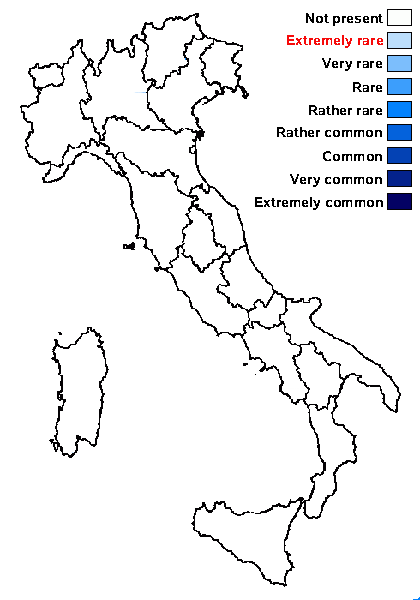Biatorella heterospora Kalb & Vězda
in Kalb, Herzogia, 6, 1-2: 73, 1983
Synonyms:
Distribution:
Description: Thallus crustose, thinly episubstratic or partly endosubstratic, whitish, often inconspicuous and poorly evident. Apothecia biatorine, 0.4-0.6 mm across, ochraceous brown to almost black, adnate, not or only slightly constricted at base, with an initially flat but soon becoming weakly to strongly convex disc, and a thin, dark, soon excluded proper margin. Proper exciple poorly developed, c. 30 μm wide laterally, of more or less parallel hyphae, I+ blue; epithecium pale to orange-yellow, inspersed with olive-blue to blue-black granules, K-; hymenium colourless, 50-60 µm high, I+ blue; paraphyses richly branched and anastomosing, 1-1.5 µm thick in lower part, the apical cells not or only slightly wider; hypothecium thick, yellowish grey, composed of interwoven hyphae, I+ blue. Asci 32-64-spored, clavate, apparently fissitunicate, but without a tholus, with a simple, K/I± faintly blue apical dome surrounded by weakly amyloid wall layers, Biatorella-type (see Hafellner & Casares-Porcel 1992). Ascospores 1-celled, hyaline, very variable in shape, from ellipsoid to bacilliform, (4.5-)7-8(-12) x 2-3.5 μm. Photobiont chlorococcoid. Spot tests: K-, C-, KC-, P-, UV-. Chemistry: without lichen substances.Note: a corticolous species, apparently rare, for the Alps reported only from Austria (Styria and Carinthia), and ecology therefore insufficiently known; the type material was on Fraxinus excelsior. To be looked for in Italy.
Growth form: Crustose
Substrata: bark
Photobiont: green algae other than Trentepohlia
Reproductive strategy: mainly sexual
Poorly known taxon in need of further study

Predictive model
Growth form: Crustose
Substrata: bark
Photobiont: green algae other than Trentepohlia
Reproductive strategy: mainly sexual
Poorly known taxon in need of further study

Predictive model
 Index Fungorum
Index Fungorum
 GBIF
GBIF

